Summary
Industrial hemp received national attention from producers after the implementation of the 2014 U.S. Farm Bill that recognized the importance of hemp as a potential commercial crop. The changing legal status prompted transitioning of row crop acres to hemp in many US states including Pennsylvania. However, there is a paucity of information regarding hemp varieties, agronomic practices such as fertilizer management, and production methods in regenerative organic systems. Research results show that stand establishment is critical, especially with no-till practices. The use of no-tillage strategies without any weed control measures can be detrimental to hemp stand establishment. Nitrogen fertilization up to 150 kg ha–1 can increase fiber and seed yield. Leguminous cover crops can supply adequate nitrogen to hemp without supplemental fertilization as indicated by similar yields among nitrogen rates in treatments that included hairy vetch and winter pea. Although hemp density was low in the no-till cover crop treatment, greater bast fiber yield per stalk significantly increased the total fiber yield, making it comparable to conventional tillage treatments. This suggests that cover crops can be considered a positive investment for hemp production. While Santhica-27 was planted for fiber production, seed yield from this variety was comparable to Earlina 8FC, a seed cultivar. Results showed that both hemp types are best suited to a conventional tillage system in the northeastern U.S. Once fully established, hemp produces a thick canopy that is impenetrable to sunlight. This suppresses weeds, which are a major consideration for organic production. We only observed the weed-suppressing effect of hemp under conventional tillage. The creation of a weed-free surface after hemp harvest is conducive for growing small grain crops such as wheat and barley. Overall, both seed and fiber hemp cultivars may not be suitable for no-till organic production and yield can be boosted with nitrogen supplementation if cover crops are not present.
1. Industrial Hemp
Industrial hemp is a type of Cannabis sativa L., designated by the USDA with less than 0.3% concentration of Tetrahydrocannabinol (THC) in any part of that plant, including seeds and all its derivatives. This is different than medical or recreational marijuana, which contains more than 0.3% THC. Medical or recreational marijuana cannot be produced with a hemp permit.
Morphologically, it is an annual crop. It produces male and female flowers on separate plants (dioecious) and grows up to 6 m tall. Hemp stems are erect, hollow, and slender. Another noticeable feature is its palmate leaf structure. Major chemical compounds such as terpenoids and cannabinoids are biosynthesized in the inflorescence. The crop is photoperiod sensitive and is typically a short-day plant. Hemp responds well to elevated CO2 and temperature levels in the context of current climate change scenarios and is a water-efficient crop.
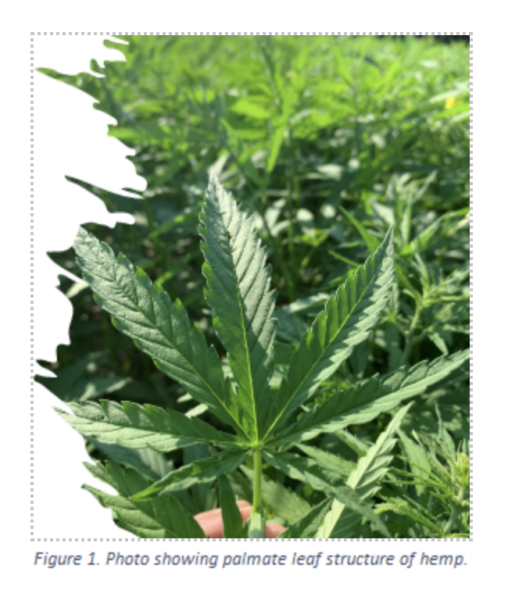
2. History and Uses
Historically, hemp use can be traced back to Paleolithic China, where its fiber was spun into a usable thread almost 50,000 years ago. It is believed that in the 16th century, it was brought to Europe to produce seed and fiber (USDA-ERS, 2019). Fiber hemp was also documented in Chile in 1545. From there it was brought to Northeastern U.S. for cultivation and eventually spread to Virginia (1775) and to other states such as Kentucky, Missouri, Kansas, and Illinois between 1840 and 1860 (USDA-ERS, 2019). Hemp was mainly used for making sail cloth for the navy in the U.S.
After the U.S. Congress passed the Marijuana Tax Act in 1937, hemp cultivation dwindled to zero until 1958. Furthermore, the Controlled Substance Act of 1970 restricted the cultivation of all hemp types until 2014. After the 2014 U.S. Farm Bill recognized the importance of hemp as a potential commercial crop, the hemp industry started to revive from its coma (Cherney and Small, 2016). The 2018 Hemp Farming Act legally removed industrial hemp from the ‘Schedule 1’ controlled substance category and allowed the crop to be grown as a commercial crop. As a result, the number of acres used for hemp production expanded from zero in 2013 to 90,000 acres in 2018 (Mark et al., 2020).
Almost all parts of the hemp plant are useful for industrial purposes (Fig. 1). Stalk and seeds are considered major commercial commodities. Stalks contain an outer bark or phloem layer called ‘bast fiber’ and an inner woody core called ‘hurd’. Bast fiber can be used in textile industries for clothing, shoes, handbags, and diapers and for applications such as construction, paper, mat, rope, insulation, and reinforcement material. Hurd is an excellent ingredient for potting mix, compost, hydroponic filler, animal bedding, mulch, absorbent products, hempcrete, fiberboard, and has hundreds of other uses. Oil can be extracted from hemp seeds to be used for cooking, beauty products, lubricants, oil paint, fuel, and varnishes, whereas the whole kernel can be used for edible flour, beer, animal feed, baked goods, and dairy products. Hemp leaves can be used to make compost and animal bedding. Indirectly, hemp provides ecosystem services by adding organic matter and sequestrating carbon in the soil, protecting soil from erosion, and preserving natural resources such as forests and water.
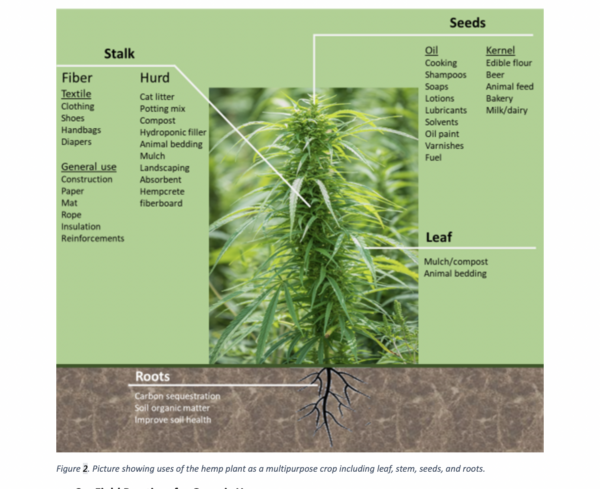
3. Field Practices for Organic Hemp
Synthetic chemicals are not permitted in organic agriculture. Fortunately, hemp requires fewer synthetic chemicals than other row crops like corn and soybeans. Growers can take herbicides and other costly weed control measures off their inventory because hemp is a smoother crop and rapidly produces a dense canopy that suppresses weeds. This makes it a perfect choice for organic production. Key considerations for successful hemp production are choosing a suitable hemp cultivar, planting method, fertilizer management, pest management, harvesting, retting, processing (optional), market opportunity, and crop rotations.
4. Climate and Soil
Hemp is adapted to well-drained soil with a pH between 6.0 to 7.5 (Univ. Wisc. Extension, 2020). Soil moisture is critical for good quality fiber because decortication can be impacted by stalk moisture content (pers. comm. Ken Meyer). Hemp prefers mild, sub-tropical climates with temperatures greater than 45°F for germination and 65°F for growth. At least 635 to 890 mm (25 to 35 in) of annual rainfall is essential without irrigation. Hemp is a heliophile crop, which means more than 6 hr of daily sunlight is essential (Univ. Wisc. Extension, 2020).
5. Know the Growth Type
There are hundreds of hemp cultivars on the market that are bred for fiber or seed production in the U.S. Choosing the right cultivar for your farm operation is crucial. It also depends on the environment and fertility level of your field. For example, seed-type hemp typically requires less nitrogen (N) and longer growing degree days than fiber-type hemp. Market opportunity and availability of processing facilities should be considered before variety selection as well.
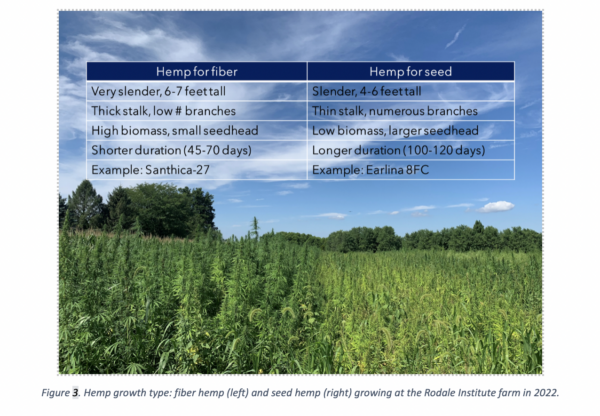
6. Planting Hemp
No planters have been developed or are readily available specifically for hemp planting. One common method for hemp planting is drilling using sorghum settings as it has a similar seed size as hemp. Similarly, a broadcast seeder can be used for seeding. Tillage is the conventional method to prepare a field for planting. For proper germination, prepare a fine seedbed with primary (moldboard or chisel plow) and secondary tillage (disc or rotary cultivator) operations. Leveling the soil surface before seeding is recommended. In the Northeast, hemp can be planted between mid-May and mid-June for fiber hemp and early May to early June for seed hemp type. The seeding rate for fiber hemp is normally greater than seed variety because it can be planted densely. Fig. 4 shows the planting density achieved with the seeding rate of 75 and 35 lbs/acre for fiber and seed hemp types, respectively. Seed hemp may require wider row spacing to maximize seed production (> 7.5 inch), whereas fiber hemp can be grown at narrower spacings.
Table 1. Planting information for fiber and seed hemp types.

No-till (NT) hemp was not successful as compared to tilled systems (CT) in Kutztown, PA (Fig. 4). Both Seed and fiber stand density was significantly lower in NT than that in CT with or without a cover crop in the system. This can be attributed to severe weed pressure and thick surface residue that was impenetrable for hemp seedlings. The lack of additional research and limited information about no-till organic hemp production continues to be a challenge.
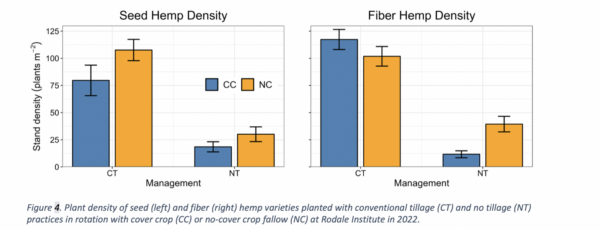
7. Fertilizer Management
Nutrient requirements for hemp in typical soil should be determined by a soil test. Recommendations for NPK can be different for seed and fiber-type hemp and depends on total N uptake by the crop. Hemp responds well to supplemental fertilizer, and biomass and seed yield can be increased by increasing N doses (Fig. 5). Research in Kutztown, PA showed that leguminous cover crops such as hairy vetch and winter pea can provide all the required N for hemp, eliminating the need for an external source of N. Without a cover crop, basal application of 100 and 150 kg N ha–1 for seed and fiber hemp, respectively, was optimal for growth and biomass production (Fig. 6). The P and K can be applied at 30-40 and 20-30 kg ha–1 for balanced nutrition. Blood meal (13:1:0.6 NPK) and compost (2:0.5-1:2 NPK) are excellent organic fertilizers. Fertilization may not be effective for no-till hemp as both seed and fiber varieties did not respond to N application (Fig. 6). This was primarily due to low stand density (section 6). Weeds may benefit from N application if they are dominant.
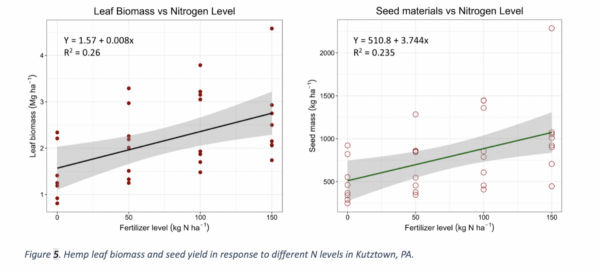
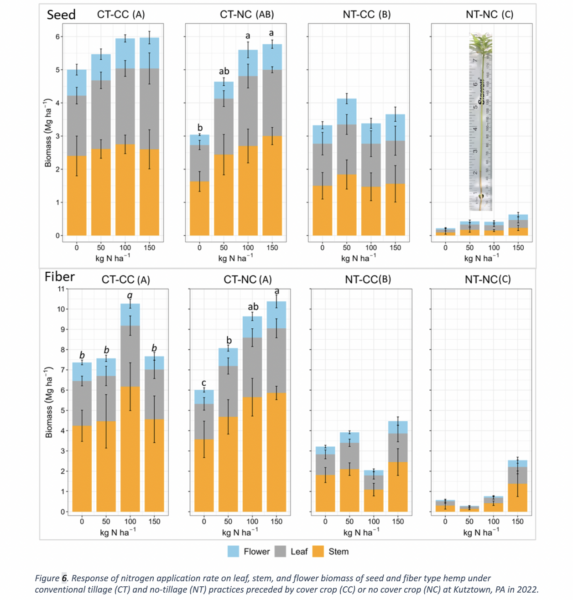
8. Weed Management
Weeds are a major concern for organic growers. Managing weeds during early crop growth stages is extremely challenging for no-till producers. Hemp biomass, including stem and seeds, can decline with increasing weed pressure (Fig. 7a). Conversely, hemp can be used as a smoother crop since it can significantly decrease weed biomass, especially broadleaf weeds (Fig. 7b). Hemp biomass of 4 Mg ha–1 or above can effectively suppress weeds, as seen in the tilled condition, whereas weeds can be problematic if hemp biomass yield does not reach that level. In the conventional tillage treatment, irrespective of the N fertilization levels, the amount of weed biomass was significantly lower than in the no-till treatment (Fig. 8). This suggests that tillage is important for hemp establishment (section 6) and subsequent weed suppression. Since it has a high weed suppression potential, including hemp in a crop rotation may deplete weed seedbank in the soil. Small grain crops such as wheat, oats, barley, buckwheat, and triticale can benefit from low weed seedbank in a crop rotation with hemp.
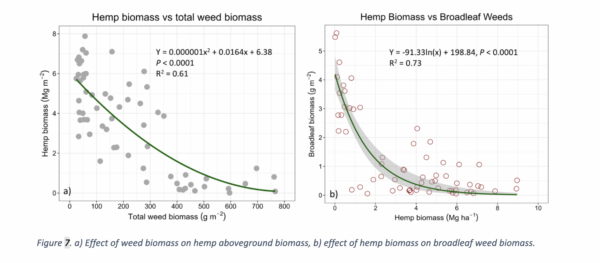
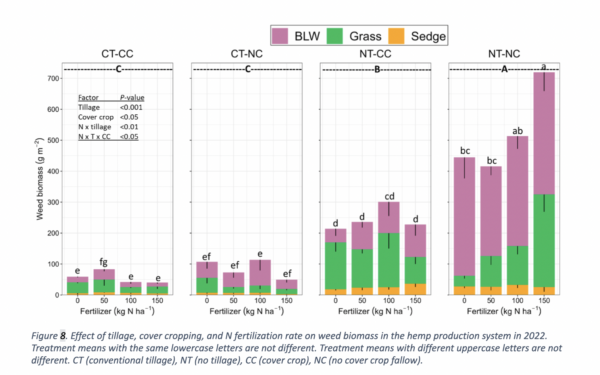
Insect-Pest Management
Insect and acarine pests can dramatically impact the yield and quality of industrial hemp in different types of agroecosystems. European corn borers (Ostrinia nubilalis), Colorado corn earworm (Helicoverpa zea), Eurasian hemp borer (Grapholita delineana), thrips, cannabis aphids (Phorodon cannabis), grasshoppers, Japanese beetles (Popillia japonica), leaf hoppers (e.g., Graphocephala versuta and Agallia constricta), tarnished plant bugs (Lygus lineolaris), red-shouldered stink bugs (Thyanta custator), hemp russet mites (Aculops cannabicola), and spider mites (Tetranychus spp.) are the most damaging hemp pests in the US (Cranshaw et al., 2019). Insect pests restrict the productivity of the hemp field by feeding on stems and leaves as well as transmitting microbial diseases. Since no registered pesticides are allowed for use in hemp, as hemp production expands, it is likely that growers will need information on the most effective integrated pest management (IPM) methods that combine cultural, mechanical, chemical, and biological strategies.
Enhancing agrobiodiversity to support the population of beneficial insects and natural predators, as well as the use of trap crops, are some examples of IPM techniques. Hemp itself supports a large group of natural enemy species. Intercropping hemp with other field crops may promote the population of natural enemies as well. Crop rotation and the use of appropriate planting density and fertilizer doses are cultural strategies that improve plant tolerance and resistance to pests. Weed management is critical as weeds harbor insect pests and diseases. Biological control agents and bio-pesticides registered to be applied in organic agriculture can be used to control insect pests.
Harvest and Post-Harvest Handling
It typically takes 50 to 70 days for fiber hemp to be ready for stalk harvest, and slightly more than 90 days for seed hemp to mature, but this number also depends on soil moisture content and temperature during the growing season. Drought may trigger early maturity and cause hemp plants to switch from the vegetative to the reproductive stage. For fiber production, plants should be harvested no later than the early seed set stage. Make sure that the plant is not water-stressed at the time of harvest to facilitate retting. Two to three-tier sickle bar mowers are effective in cutting thick and tall stalks and allow for field retting. For seed production, seed heads should be harvested when more than 70 percent of the seeds are ripe and begin to shatter. The grain moisture content at harvest should be about 18 to 25 percent. Planting short-stature varieties allows for a combine harvester to be effectively used for grain harvest. The taller varieties may create problems because their stalks can be wrapped up in the reaper. Delayed harvesting may increase shattering, resulting in yield loss and volunteer hemp emergence in the fall. Harvested seeds should be dehydrated to 15 percent or lower for storage.
Retting is a microbial process that breaks chemical bonds between bast fiber (whole bark) and hurd (woody core) and allows for fiber extraction. Dew or field retting is an inexpensive and easy way to ret hemp stalks. After mowing with a sickle bar mower, field retting in an open environment takes up to five weeks. Leaving 6-inch-tall hemp stubble helps to maintain an air gap between the soil surface and windrow to prevent fungus development and facilitate drying. It is advisable to rake windrows a couple of times to remove leaf material. Once the hemp is ready to collect, it can be packed into square or round shape bales and transported to a processing facility. During a process called ‘scutching’ or ‘decortication’, properly retted hemp stalks are passed between fluted rollers, which breaks the hurd into pieces and separates it from the fiber. There are several decorticator facilities around the country with a processing capacity of more than 1 MT hr–1.
Yield
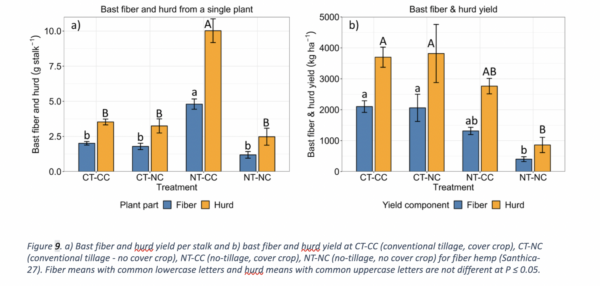
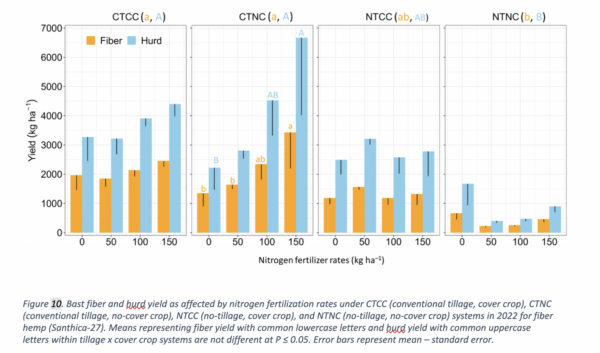
We found thicker fiber hemp stalks with more fiber and hurd in the no-tillage cover crop treatment (NTCC) than in any of the conventional tillage treatments (conventional tillage, cover crop, CTCC; conventional tillage, no-cover crop, CTNC) and the no-tillage fallow (NTNC) (Fig. 9a). The greater plant productivity at NTCC increased bast fiber and hurd yield, making it comparable to the CT treatments (Fig. 9b). The bast fiber yield was 2.1 MT ha–1 under conventional tillage and 0.86 MT ha-1 under a no-till system. Nitrogen application rates affected bast fiber and hurd yield under CTNC but did not affect yield under no-tillage and cover crop-based systems (Fig. 10). Under the CTNC system, both hurd and fiber yield can be maximized with 150 kg M ha–1. However, the variability in yield was substantially higher than under lower application rates (Fig. 10).
Although Santhica-27 is known for fiber production, seed yield from this variety was comparable to yield from a typical seed-type cultivar (Earlina 8FC) (Fig. 11a). Tillage impacted the seed yield, with a higher yield under conventional tillage systems (724 kg ha–1), compared to no-tillage (394 kg ha–1). Lower plant density and high weed pressure impacted seed yield in no-tillage treatments. Increased nitrogen application rates led to increased grain yield (Fig. 12), especially in CTNC. Santhica-27 response to N application was greater than Earlina 8FC while no-tillage mostly favored Earlina 8FC in producing grain (Fig. 12).
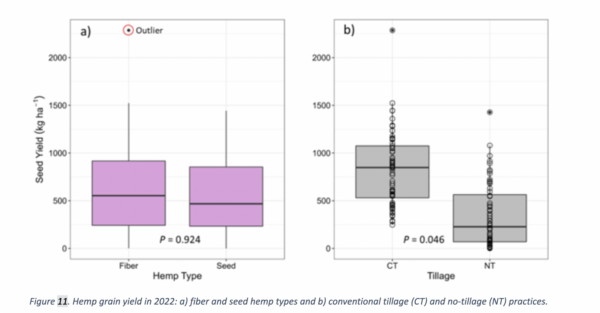
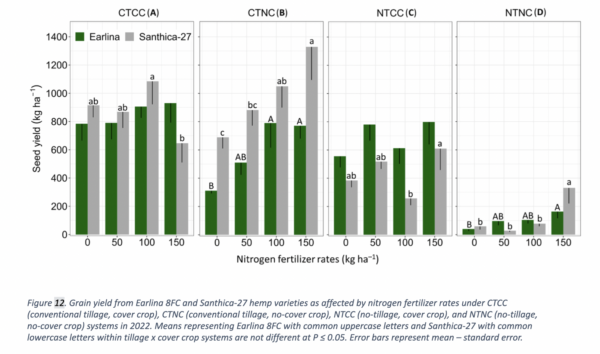
Market Opportunities and Economics
There are hundreds of potential uses for bast fiber and hemp seed. In 2021, the National Hemp Association (NHA) released a report on the economic impact of the hemp industry in the U.S. The report projected an impact of $32 B for industrial hemp by 2030.
As of May 2023, growers were paid up to US $300 per ton for raw fiber hemp material and up to US $11 per pound for processed organic seed. While the seed price has an organic premium, there is no price premium for organic fiber hemp. The NHA has been continuously lobbying for market regulations and price premiums for organic hemp so the fluidity in price and policy can be reduced at the federal and state level. Based on combined economic data reported by Penn State Extension and Grower’s Associations, the range of returns over total cost is between US $74 and $1220 acre–1 for fiber hemp and about US $550 acre–1 for seed hemp. These calculations were based on 100 acres of operation.
Despite hemp’s potential to be a lucrative cash crop, it is still difficult to find a sales channel before production and concrete market information about prices. This is mainly caused by longstanding legal battles and adverse government policies (see section 2) that made this crop illegal, which disrupted the chain of supply and demand. Thus, growers should consider local market opportunities, laws, transportation and input cost, and agronomic factors before starting hemp production.
Acknowledgment
This research was supported by the Pennsylvania Conservation Innovation Grants under Natural Research Conservation Service of the United States Department of Agriculture (USDA). We would like to thank technical and scientific personnel from the Rodale Institute, for providing research facilities and support throughout the experiment.

